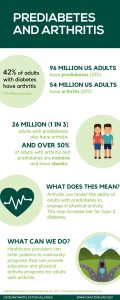Prediabetes and Arthritis
26 million adults with prediabetes (about 1 in 3) have arthritis, and approximately half of those with both conditions are physically inactive or have obesity.
What Is Prediabetes?
Prediabetes is a serious health condition where blood sugar levels are higher than normal, but not high enough yet to be diagnosed as type 2 diabetes.
Physical inactivity and obesity are two factors associated with an increased risk for developing type 2 diabetes, and arthritis has been determined to be a barrier to physical activity among adults with obesity. The comorbid burden of arthritis and prediabetes is substantial, particularly among persons aged ≥65 years, women, and non-Hispanic whites.
What can you do?
Programs such as the National Diabetes Prevention Program and other evidence-based, community programs, can help you learn how to manage pre-diabetes or diabetes and arthritis.
There are several physical activity programs available for adults with arthritis and similar chronic conditions, like EnhanceFitness, Walk with Ease, Active Living Every Day, and Tai Chi for Arthritis. These programs can address arthritis-specific barriers to being physically active through classroom learning and group exercise.
Try to be active for 150 minutes a week. That’s just 30 minutes a day, five days a week of brisk walking or similar activity. But any amount of increase in physical activity is helpful for both immediate and long-term health benefits.
Stay educated about the best ways to help manage your health. Head to any of the links below to keep learning about weight management, prediabetes and diabetes, arthritis, and more.
Resources:
OAAA Resource Library: Weight Management
OAAA Resource Library: Living Better with Osteoarthritis
CDC: Healthy Weight
CDC: Living With Diabetes
CDC: Arthritis
Sources:
CDC Morbidity and Mortality Weekly Report (MMWR) on Prevalence of Arthritis Among Adults with Prediabetes and Arthritis-Specific Barriers to Important Interventions for Prediabetes.
CDC Prediabetes
CDC Diabetes
